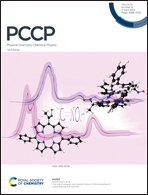Low-frequency inductive features in the electrochemical impedance spectra of mass-transport limited redox reactions†
Abstract
Low-frequency (lf) inductive features in the impedance spectra of electron-transfer reactions at the electrode–electrolyte interface in acidic and alkaline media are investigated. The trend in lf equivalent circuit (EC) parameters (inductor (L) and series resistance (R0)) is analysed as a function of overpotential for the two widely investigated electrochemical reactions, viz., methanol oxidation reaction (MOR) and oxygen reduction reaction (ORR). The decreasing trend in the lf EC parameter values of the reactions not limited by mass-transport (such as the MOR) and that in the mixed kinetic-diffusion controlled region for mass-transport limited reactions (ORR) are attributed to the faster surface relaxation with applied overpotential, whereas the increase of the L and R0 values in the mass-transport limiting region in an acidic medium is shown to originate from the extra hindrance caused by the limited supply of reactant species. Such analysis of lf EC parameters with overpotential is important to understand the underlying physical processes and to establish equivalent circuit models.



 Please wait while we load your content...
Please wait while we load your content...